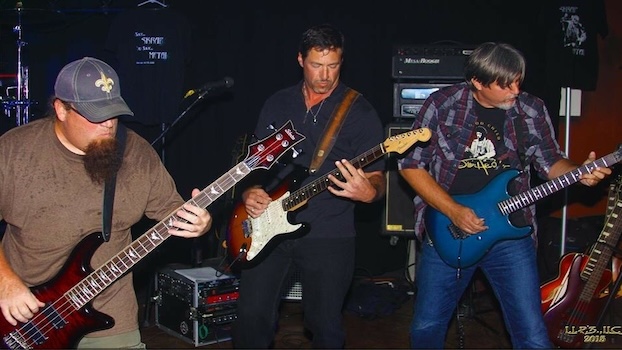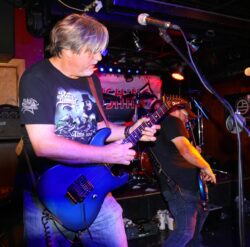
Let’s kick things off with something that might surprise you. Is it a chord? Is it a scale? Is it a riff?
No, it‘s attitude!
Every detail, from the way you hold the guitar properly to your stance, and even your facial expressions, all feed into this.
Mastering rock guitar isn’t just about precision; it’s about unleashing raw energy through your strings. In this article, we’ll cover essential rock guitar techniques every beginner should know to start playing with confidence.
*P.S: NOT discussing any music theory in this one, okay?
To truly get into the groove, your stance is very important. Are you slouched or standing tall? Relaxed or tense? Your posture directly impacts your playing style and the emotion you channel into your music.
Your grip is your direct connection to the guitar—use it with intent. Press those chords with intent, strum with precision, and feel every note resonate. The right technique not only enhances your sound but also helps prevent strain, keeping you playing longer and stronger.
Rock ‘n’ roll thrives on being gritty, messy, and full of raw power.
It’s all about distortion, aggressive rhythms, and powerful solos that set it apart from other genres. Imagine the growl of a power chord or the scream of a face-melting guitar solo. That’s the essence of rock—raw emotion through sound.
Attitude is the foundation of rock guitar. It influences your playing style, stage presence, and how your music connects with listeners. So, while technique is important, embracing your unique style and energy is what truly makes a great rock guitarist.
As I often say here at String Shock, there’s only ONE of YOU, so don’t be overly concerned about other guitarists out there, alright? Just focus on your own techniques and attitudes within your playing.
It’s important to first lay down the rock-solid foundation with some must-know techniques. Mastering these will not only power up your playing but also infuse your performances with that quintessential rock attitude we talked about.
These rock guitar techniques will help you shred like a pro in no time:
It is a must-know technique for rock and metal guitarists. By lightly resting the edge of your picking hand on the strings near the bridge, you create a tight, chugging sound perfect for rock rhythm guitar.
Palm muting is an essential technique in rock and metal, helping create tight, punchy rhythms.
Pro Tip: Practice on the low E and A strings, starting with slow, controlled downstrokes. Gradually increase speed while maintaining clarity.
Rock music relies heavily on strong rhythm guitar playing. Get your whole body involved—tap your foot, bang your head, and let your energy flow into your playing. Let that attitude flow from out of your mind!
Rhythm is about feel—lock into the groove by playing along with a drum track or metronome.
Natural harmonics produce bell-like tones when you lightly touch the string at the 5th, 7th, or 12th fret while plucking. They add brightness and texture to your playing.
Pinch harmonics (a.k.a. guitar squeals) create a high-pitched scream by lightly catching the string with your thumb right after picking. You can uncover all types of mysterious notes depending on where you strike the string. This technique is a staple in rock and metal guitar solos.
The whammy bar adds expressiveness to your playing, letting you dive, bend, and add vibrato to your notes. Start with subtle vibrato before experimenting with more dramatic effects like dive bombs, where you hit a note and push down on the bar all the way.
Hammer-ons and pull-offs are essential rock guitar techniques that help create smooth, lightning-fast licks with minimal picking. A hammer-on happens when you pick a note and then press a higher fret with another finger without picking again, creating a seamless transition.
A pull-off does the opposite—lifting your finger off a fretted note to let a lower note ring out naturally. These techniques are the foundation of legato playing, allowing you to achieve effortless speed and fluidity in solos, just like Eddie Van Halen, Joe Satriani, and Steve Vai.
Vibrato is the secret weapon behind a powerful, expressive rock guitar tone. By slightly bending and releasing a note repeatedly, you create a rich, singing quality that adds depth to your playing.
The key to mastering vibrato is control—whether it’s a slow, wide vibrato like B.B. King or an aggressive, rapid shake like Zakk Wylde, developing your own vibrato style can give your playing a unique signature. This technique makes every note stand out, helping you craft solos that truly sing.
String bending is one of the most iconic rock guitar techniques, giving your solos a vocal-like quality that conveys raw emotion. To execute a bend, push or pull the string across the fretboard to raise the pitch, aiming for a precise half-step or full-step jump.
Guitar legends like David Gilmour and Slash use bends to create soaring, expressive melodies. To master this technique, focus on ear training and finger strength, ensuring that each bend reaches the correct pitch and adds the perfect amount of intensity to your solos.
More techniques to help you shred like a pro;
Tapping is an advanced technique used by legends like Eddie Van Halen. It involves using both hands on the fretboard to create fast, fluid melodies. Start with basic hammer-ons and pull-offs before moving on to full two-handed tapping sequences.
Rock guitarists use feedback to create long, sustaining notes by controlling their guitar’s proximity to the amp. Experiment with different angles and distances to harness that signature rock sound.
Rock ‘n’ roll thrives on controlled chaos. Spend time practicing, and gradually, you’ll feel the raw power of these techniques feeding into your playing.
As you finish with the intricate work of advanced techniques, it leads you naturally to want to keep pushing the boundaries. In my opinion, that’s the mark of a true musician: the desire to perpetually grow, learn, and challenge oneself.
And that’s exactly where we’re heading in the next section.

Perfecting techniques like palm muting, pinch harmonics, and whammy bar dives is just the beginning. Rock guitar mastery is a journey—keep practicing, experimenting, and pushing your limits.
Whether it’s the soul-piercing squeal of pinch harmonics or the rhythmic complexity of an expertly executed two-handed tapping riff, your rock guitar journey is unique. There’s endless opportunity to explore different styles, techniques, and nuances that define your personal sound.
Don’t stress about perfecting everything at once. Rock guitar is about feel, and a lot happens quickly when you’re deep in the music. It’s okay to refine your technique over time—every great guitarist started somewhere.
I hope you take these techniques and use them not just to imitate the greats but to develop your own signature style in the great halls of rock ‘n’ roll.
In my opinion, the standard of a true rock guitarist isn’t just about technical proficiency; it’s also about the willingness to push boundaries and the courage to let your individuality shine through your music.
So, pick up that guitar, CRANK UP YOUR AMP TO 11 (Spinal Tap) and let the world hear what you’ve got. Rock has always been about an expression of the soul.
As you progress, keep fueling your passion. Engage with other musicians, learn from rock legends, listen to a wide range of music, and never stop pushing the boundaries of what you can do with six strings and a pick.
Your guitar journey doesn’t end here—it’s just beginning.

Lorem ipsum dolor sit amet, consectetur adipiscing elit. Praesent sit amet elementum massa. Ut gravida risus at dui dapibus tristique...Read More